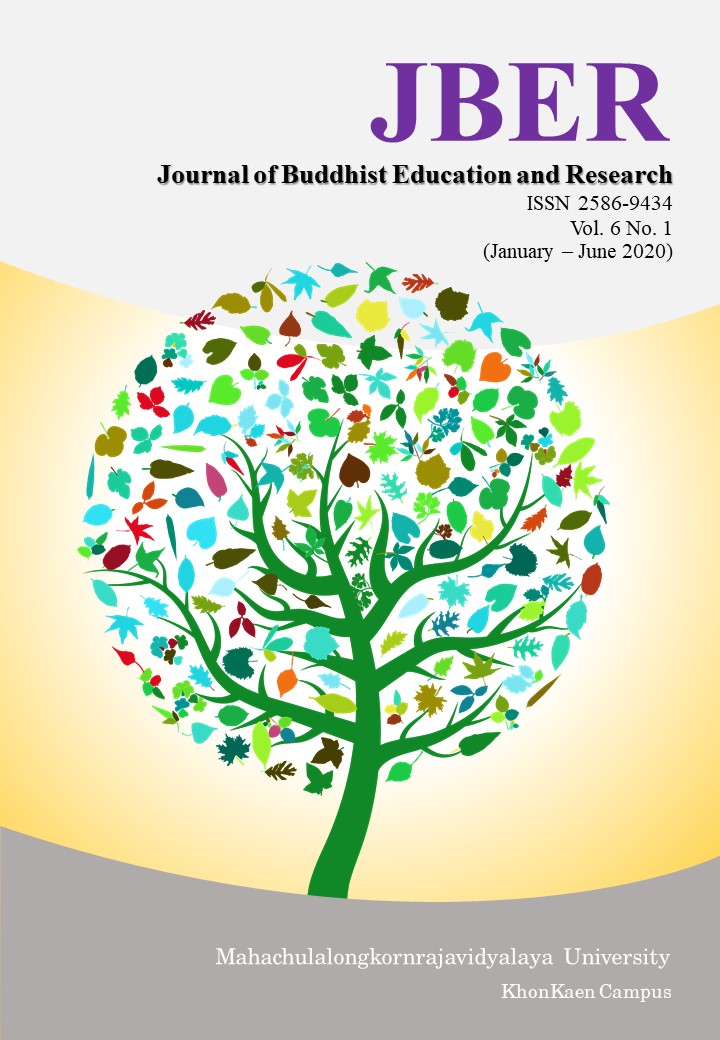THE INTEGRATED LEARNING MANAGEMENT OF BUDDHIST INNOVATIVE WAYS OF LIFE: CASE STUDY OF INDIGO DYED FABRIC HANDICRAFT OF TAD VILLAGE COMMUNITY PHAET SUB-DISTRICT KHAMTAKLA DISTRICT SAKONNAKHON PROVINCE
Keywords:
integrated learning management, Buddhist innovative ways of life, indigo dyed fabric handicraftAbstract
The aims of this research were: to study the conditions, the integrated learning management of Buddhist innovative ways of life; present the ways and suggestions for the integrated learning management of Buddhist innovative ways of life in the case study of the indigo dyed fabric handicraft in Tad Village community, Phaet sub-district, Khamtakla district, Sakonnakhon province. This study was carried out by means of the qualitative research methodology. The target-samples included 5 village philosophers, 10 members of indigo fabric dyeing group, 3 teachers in Tad village school, 2 monks in Ban Tad forest temple (total 20). The data were collected by using the interview form before being interpreted by means of the descriptive analysis.
The research results were as follows:
1. Indigo dyeing is a tradition inherited from the ancestors of the Tad villagers. The villagers have moved from Laos, speak Laos and live in the Akat Amnuai district, Khamtakla district and Wanorn district. Therefore, they have a way of life like a farmer for rice farming, gardening and they live a simple life. In the old days, indigo dyed fabrics were made and used only by themselves. This is inherited from the old people in the village together with farming and gardening occupations. There are indigo trees planting to make indigo cloths. When outside people know this, it brings income to the community.
2. The integrated learning management of Buddhist innovative ways of life can be done by using the eightfold noble paths in the integration together with using the following principles in the workplace, such as honesty with oneself, learning about ways of life, culture, traditions, morality and ethics of the community and indigo dyeing handicrafts in the management, cooperation between houses, temples, schools, learning source support, and external sources of knowledge, principles of working together, principles of holding the mind, production principles and sustainable group management.
3. The ways of the integrated learning management of Buddhist innovative ways of life in the case study are that indigo dyed fabric is caused by the cooperation between houses, temples, schools, using the eightfold noble paths as a principle used in indigo dyeing; this causes satisfaction, curiosity, integrative thought of new things that were taken into consideration for success. The principles of holding the mind to visitors are generosity, friendliness, kindly speech, honesty, propriety, beneficiating the others with the highest attempt, praise, consistency and paying attention to work, intelligence, patience on duties and being in a good spirit to the community visitors.
References
ชูชีพ เอื้อการณ์และคณะ. (2557). วิจัยแนวทางการส่งเสริมและพัฒนาอุตสาหกรรมสิ่งทอไทยเพื่อการแข่งขันระดับโลก. ปทุมธานี: มหาวิทยาลัยราชภัฏวไลยอลงกรณ์ในพระบรมราชูปถัมภ์.
ดนัย ชาทิพฮด. (2558). ผ้าย้อมคราม: การทำวัฒนธรรมให้กลายเป็นสินค้าในกระแสโลกาภิวัตน์. วารสารไทยศึกษา. 10(2), 87-116.
ธัญญธร ศรีวิเชียร. (2560). กลยุทธ์การตลาดบริการสาหรับธุรกิจร้านผ้าพื้นเมืองในภาคตะวันออกเฉียงเหนือ. มหาสารคาม: มหาวิทยาลัยมหาสารคาม.
พระสมุห์พรเลิศ วิสุทฺธสีโล. (2557). การศึกษามรรคมีองค์ 8 เพื่อการบรรลุธรรมในคัมภีร์พระพุทธศาสนาเถรวาท. วิทยานิพนธ์พุทธศาสตรบัณฑิต สาขาวิชาพระพุทธศาสนา. บัณฑิตวิทยาลัย มหาวิทยาลัยมหาจุฬาลงกรณราชวิทยาลัย.
พระธรรมปิฎก (ป.อ. ปยุตฺโต). (2550). พระพุทธศาสนาพัฒนาคนและสังคม. กรุงเทพฯ: กรมการปกครอง.
สุทธิพงษ์ พูลเพิ่ม และจุรีวัลย์ ภักดีวุฒิ. (2558). กลยุทธ์การพัฒนาผลิตภัณฑ์ผ้าไหมลายสาเกตบ้านหวายหลึมสู่ตลาดอาเซียน. กรุงเทพฯ: มหาวิทยาลัยเกษตรศาสตร์.
สำนักส่งเสริมภูมิปัญญาท้องถิ่นและวิสาหกิจชุมชน กรมการพัฒนาชุมชน กระทรวงมหาดไทย. (2562). สืบค้นเมื่อ 29 สิงหาคม 2562.จาก https://cep.cdd.go.th/otop.
อนุรัตน์ สายทอง. (2555). ไหมย้อมครามธรรมชาติ ในวารสารวิทยาศาสตร์ มข. ขอนแก่น: มหาวิทยาลัยขอนแก่น,
Branda Neidigh. (2001). An Analysis of E-commerce Integration in the Textile. Industry. Retrieved May 5, 2019. from http://www.Ecorridors.





